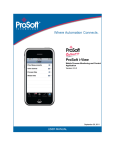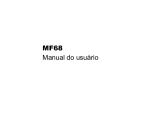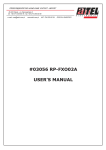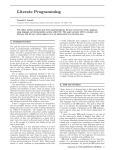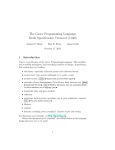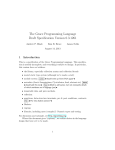Download For Dummies C# 2010 All-in-One
Transcript
Chapter 1: Programming
Dynamically!
AL
In This Chapter
✓ Understanding dynamic typing
✓ Making static operations dynamic
MA
F
TE
✓ Putting dynamic to use
RI
✓ Defining variables
D
or many years, I thought that dynamic programming referred to being
really flashy and flamboyant while writing code. So, I started wearing
Hawaiian shirts and singing loudly.
TE
Later, I found out this isn’t the case.
GH
Dynamic programming is another one of those buzzwords that really doesn’t
have a clear definition. At its loosest, it means developing something in such
a way that the program makes more decisions about the way it runs while
running, rather than when you compile it.
PY
RI
Scripting languages are a great example of this. When you write something
in VBScript, you don’t compile it at all — all of the decisions are made at
runtime. Ruby is another good example: Most of the time, an entire program
can just be typed into a command prompt and run right from there.
CO
There are examples that are not so good — like VB Classic. Remember the
Variant type? You could declare a variable to be Variant and VB wouldn’t
decide what it was supposed to be for real until the program ran. In the
best of cases, this added immense flexibility to the language. In the worst of
cases, you got Type Mismatch errors at runtime.
To give a concrete example, when you declare a variable in a dynamically
typed language, you don’t have to say what type you are making that variable. The compiler will just figure it out for you. In a static language, like C#
3.0, you do have to say what type you are making that variable.
Microsoft originally promised that dynamic types would never be in C#,
but later decided that the feature had to be added. Why? Mostly, it’s
because of the development for Microsoft Office (like the reasoning for
much of the rest of Book VIII). Office uses COM, the pre-.NET structure for
Microsoft applications.
770
Shifting C# Toward Dynamic Typing
COM expects that the languages that use it (like VB Classic and C++) will
have dynamic types. This made developing for Microsoft Office difficult for
C# programmers, which was exactly opposite of what Microsoft wanted to
happen. The end result? The dynamic type.
Shifting C# Toward Dynamic Typing
So-called “dynamic languages” are a trend that keeps coming back, like ruffled tux shirts. Dynamic languages are languages that allow for loose typing,
rather than static. The concept got started in the 1960s with LISP. Dynamic
languages came back in the late 1980s for two reasons: network management
scripting and the artificial intelligence craze. Thanks to the Web, the buzzword is back yet again.
The World Wide Web, for those of you who aren’t old enough to remember, was built on View Source and dynamic languages. Microsoft’s original
Web development language, Active Server Pages, was built on VBScript — a
dynamic language.
The Web is better with a dynamic programming environment, so the trend
is probably here to stay this time (until the next big thing, anyway). C# isn’t
the only language that is adding dynamic language features, and dynamic
type isn’t the only language feature that has been added to make it more
appealing for Web programmers.
Several dynamic languages have been around for a while, like these:
✦ Perl
✦ Visual Basic
✦ Smalltalk
✦ LISP
✦ Scheme
While some of these aren’t as popular as they once were, they are still out
there and have pushed the trend in the newer languages. You can see this
trend in all the new or refurbished dynamic languages that have popped up
over the last ten years. Many of them have roots in the Web, while others
are being newly used for the Web:
✦ PHP
✦ Ruby
✦ JavaScript
✦ Cold Fusion
Shifting C# Toward Dynamic Typing
771
✦ Python
✦ Cobra (my new favorite)
✦ Groovy
✦ Boo
✦ Newspeak
Programmers who work in dynamic languages — how can I put this gently —
feel strongly about their choice of tools. The communities are very strong.
Developers who work in dynamic languages use them for practically everything except highly structured team-build kinds of environments, like:
✦ Scripting infrastructure for system maintenance
✦ Building tests
✦ One-use utilities
✦ Server farm maintenance
✦ Scripting other applications
✦ Building Web sites
✦ File maintenance
Dynamic languages are popular for these kinds of tasks for two reasons.
First, they provide instant feedback, because you can try a piece of code
outside the constraints of the rest of the program you are writing. Second,
you can start building your higher-level pieces of code without building the
plumbing that makes it work.
For instance, Ruby has a command line interface that you can simply paste
a function into, even out of context, and see how it works. There is even a
Web version at http://tryruby.hobix.com/. You can type code right in
there, even if there are classes referenced that aren’t defined, because Ruby
will just take a guess at it.
All of this lends itself to a language that is a lot more responsive to change.
You can make a logic change in one place and not have to dig through reams
of code to fix all the type declarations everywhere. Add this to optional and
named parameters (see Chapter 2) and you have a lot less typing to do when
you have to change your program.
Programming
Dynamically!
This moves nicely into the next point, that a dynamic language enables you
to build a class that refers to a type that you haven’t defined elsewhere. For
example, you can make a class to schedule an event, without actually having
to build the underlying Event type first.
Book VIII
Chapter 1
772
Programming Dynamically
Other benefits to dynamic languages in general show up as you use them
more. For instance, macro languages are usually dynamically typed. If you
have tried to build macros in previous versions of Visual Studio, you know
what a pain it is to use a static language.
Making C# (and VB.NET, for that matter) more dynamic not only makes it a
better language for extending Visual Studio, but it also gives programmers
the capability to include the language in the programs they write so that
other developers can further extend those applications.
Programming Dynamically
By now, you must be asking, “What exactly are we talking about here?” Fair
question. When you define a new variable, you can use the dynamic keyword,
and C# will let you make assumptions about the members of the variable.
More or less, what I’m talking about it this. If you want to declare a new
Course object, you do it like this:
Course newCourse = new Course();
newCourse.Schedule();
This is, of course, assuming that you have a Course class defined somewhere
else in your program, like this:
class Course {
public void Schedule()
{
//Something fancy here
}
}
But what if you don’t know what class the new object will be? How do you
handle that? You could declare it as an Object, because everything derives
from Object, right? Here’s the code:
Object newCourse = new Object();
Not so fast, my friend, if you make your next line this:
newCourse.Schedule();
Note the squiggly line appears almost immediately, and you get the famous
“object does not contain a definition for Schedule...” error in the design time
Error List.
Programming Dynamically
773
However, we can do this:
dynamic newCourse = SomeFunction();
newCourse.Schedule();
All this code needs to have is the stub of a function that returns some value,
and we are good to go. What if SomeFunction() returns a string? Well, we
will get a runtime error. But it will still compile!
About now, if you are anything like me, you have to be thinking: “This is a
good thing? How!?!” I hear you, trust me. For the time being, you can blame
COM.
You see, COM was mostly constructed using C++, which has a variant type.
In C++, you could declare a variable to be dynamic, like this:
VARIANT newCourse;
It worked just like the dynamic type, except C# wasn’t invented yet. Anyway,
because a lot of the objects in COM used Variant out parameters, it was
really tough to handle Interop using .NET.
Because Microsoft Office is mostly made of COM objects, and because it isn’t
going to change any time soon, and because Microsoft wants us all to be
Office developers one day, bam, we have the dynamic type.
Say, for instance, that our newCourse is a variant out parameter from a
method in a COM class. In order to get the value, we have to declare it an
Object, like this:
CourseMarshaller cm = new CourseMarshaller(); //a COM object
int courseId = 4;
Object newCourse;
cm.MakeCourse(courseId, newCourse);
//and now we are back to square one
newCourse.Schedule(); //This causes a ‘member not found
exception’
With a dynamic type, though, we are golden once again, with this code:
CourseMarshaller cm = new CourseMarshaller(); //a COM object
int courseId = 4;
dynamic newCourse;
cm.MakeCourse(courseId, newCourse);
newCourse.Schedule(); //This now compiles
Programming
Dynamically!
Line six will not compile, even if the Schedule method exists, because we
can’t assume that newCourse will always come back as a Course object,
because it is declared a variant. We are stuck.
Book VIII
Chapter 1
774
Putting Dynamic to Use
What happens if newCourse comes back as something that doesn’t have a
Schedule method? You get a runtime error. But there are try/catch blocks
for runtime errors. Nothing will help it compile without the dynamic keyword.
Readers who are long-time Visual Basic programmers, or even newer VB.NET
programmers, realize that you can handle this dynamically — and have
always been able to — in Visual Basic. For a long time, I have recommended
that programmers working with legacy systems use Visual Basic for their
new code, and this is exactly why.
In the interest of language parity, now C# can do it, too. In general, this is
good, because many organizations are writing legacy code in VB and new
code in C# — and it can get pretty messy in the trenches. This change makes
the code base slimmer.
Putting Dynamic to Use
When C# encounters a dynamic typed variable, like the variables we created
earlier, it changes everything that variable touches into a dynamic operation.
This dynamic conversion means that when you use a dynamically typed
object in an expression, the entire operation is dynamic.
Classic examples
There are six examples of how this works. Say we have the dynamic variable dynaVariable. Because the dynamic variable will pass through all six
examples, they will all be dispatched dynamically by the C# compiler. Here
are those examples, with nods to Daniel Ng.
✦ dynamicVariable.someMethod(“a”, “b”, “c”);: The compiler
binds the method someMethod at runtime, since dynaVariable is
dynamic. No surprise.
✦ dynamicVariable.someProperty = 42;: The compiler binds the
property someProperty just like it did in the first method.
✦ var newVar = dynamicVariable + 42;: The compiler looks for any
overloaded operators of “+” with a type of dynamic. Lacking that, it outputs a dynamic type.
✦ int newNumber = dynamicVariable;: This is an implicit conversion
to int. The runtime determines if a conversion to int is possible. If not,
it throws a type mismatch error.
Putting Dynamic to Use
775
✦ int newString = (int) dynamicVariable;: This is an explicit
cast to int. The compiler encodes this as a cast — you actually change
the type here.
✦ Console.WriteLine(dynamicVariable);: Because there is no overload of WriteLine that accepts a dynamic type explicitly, the entire
method call is dispatched dynamically.
Making static operations dynamic
If the compiler chooses to make a static operation dynamic — as it did in
item 6 in the preceding section — the compiler rebuilds the code on the fly
to have it handle the dynamic variable. What does that mean for you? Glad
you asked.
Let’s take item 6, Console.WriteLine(dynamicVariable);. This piece
of code forces the compiler to build intermediary code, which checks for the
type of variable at runtime in order to come up with something that is writable to the console. The compiled code first checks if the input is a static
type that it knows. Next, it checks for a type present in the program. Then
it will just try a few things that might work. It will fail with an error if it finds
nothing.
If this must happen, that’s fine. But remember that it is slower than all
git out. This is why Variant got such a bad rap in Visual Basic classic.
Dynamic is something you don’t use until you need it. It puts a tremendous
strain on the machine running the program, especially if all variables are
dynamic.
Understanding what’s happening under the covers
Let’s take an example right out of MSDN. Microsoft points out this simple
method:
This is pretty straightforward stuff — a method that accepts a dynamic class
and returns the results of the type’s Foo method. Not a big deal.
Book VIII
Chapter 1
Programming
Dynamically!
class C
{
public dynamic MyMethod(dynamic d)
{
return d.Foo();
}
}
776
Running with the Dynamic Language Runtime
Here is the compiled C# code:
class C
{
[return: Dynamic]
public object MyMethod([Dynamic] object d)
{
if (MyMethodo__SiteContainer0.p__Site1 == null)
{
MyMethodo__SiteContainer0.p__Site1 =
CallSite<Func<CallSite, object, object>>
.Create(new CSharpCallPayload(
CSharpCallFlags.None, “Foo”,
typeof(object), null,
new CSharpArgumentInfo[] {
new CSharpArgumentInfo(CSharpArgumentInfoFl
ags.None,
null) }));
}
return MyMethodo__SiteContainer0.p__Site1
.Target(MyMethodo__SiteContainer0.p__Site1, d);
}
[CompilerGenerated]
private static class MyMethodo__SiteContainer0
{
public static CallSite<Func<CallSite, object,
object>> p__Site1;
}
}
Yeah, that’s what I said, too. I am not going to even begin to try breaking
down this code — and fortunately, we don’t have to. That’s what we have
compilers for, right?
Running with the Dynamic Language Runtime
There is more to dynamic languages than just the dynamic typing. You
can do some powerful things. Like all power, you have to be careful not to
misuse it.
The Dynamic Language Runtime — shown in Figure 1-1 — is a library added
to the .NET Framework specifically to provide for adding dynamic languages
(like Ruby) to the Visual Studio fold (like IRONRuby), or to add dynamic language features to existing static languages (like C# 4.0).
Running with the Dynamic Language Runtime
777
Figure 1-1:
The
Dynamic
Language
Runtime.
The runtime helps the compiler to construct code in the compiled assembly
that will make a lot of choices dynamically. The code block at the end of the
preceding section is an example of the simplest kind.
The DLR assisted in the creation of IRONRuby, which makes it possible to
code in Ruby — the current hot dynamic language — right in Visual Studio.
Of course, because the DLR enables C# to take on dynamic language features, much that you can do in Ruby you can now do in C#.
Dynamic Ruby
Ruby takes advantage of its dynamic roots in its implementation of the
Trabb Pardo-Knuth algorithm. Don’t be put off by the name — this is just a
straightforward problem that can be solved by computer code.
The program needs to read 11 numbers from an input device — in our case,
the console’s ReadLine method. It stores them in an array. Then, it processes the array backward — starting from the last entered value — with
some function. If the value doesn’t exceed some arbitrary threshold, it prints
the result.
class TPK
def f( x )
return Math.sqrt(x.abs) + 5*x **3
end
Programming
Dynamically!
The program looks like this in Ruby:
Book VIII
Chapter 1
778
Running with the Dynamic Language Runtime
def main
Array.new(11) { gets.to_i }.reverse.each do |x|
y = f(x)
puts “#{x} #{(y>400) ? ‘TOO LARGE’ : y}”
end
end
end
This isn’t a Ruby book, and that fact isn’t lost on me. Nonetheless, this is the
best dynamic language that I can use for an example — bar none.
Two functions are defined: f and main. Main accepts 11 numbers from the
console and then moves them to an integer array (that’s what gets.to_i
does). For each value in the array, it sets y equal to f(x) and then sees if it
is higher than our arbitrary value. If so, it prints “TOO LARGE”; otherwise, it
prints the number.
Why is being dynamic important for this algorithm? It isn’t. You could do it
all statically typed. The dynamic bit does have an impact, though.
First, f(x) doesn’t care what x is. The program assumes that whatever
comes in gets changed to an integer at gets.to_i, but the function itself
is case agnostic. This is good and bad, because if we do happen to give it a
string or some other type, it will fail.
The array itself isn’t typed, either. This can have benefits, because it is possible to drop a differently typed value in there if you know you are just going
to write it to the screen.
Dynamic C#
Of course, C# now has similar features, right? We should be able to do the
same thing! Yes, in fact, we can. Here’s the code:
static dynamic f(dynamic x)
{
return (Math.Sqrt(x) + 5.0 * Math.Pow(x, 3.0));
}
static void Main(string[] args)
{
dynamic[] array = new Array[11];
for (int i = 0; i < 11; i++)
{
array[i] = Console.ReadLine();
}
for (int i = 10; i>=0; i--)
{
Running with the Dynamic Language Runtime
779
dynamic y = f(array[i]);
if (y > 400.0)
{
Console.WriteLine(string.Format(“{0} TOO
LARGE”, i));
}else{
Console.WriteLine(“{0} : {1}”, i,
array[1]);
}
}
Console.ReadKey();
}
Line for line, the application does the same thing as the Ruby code, albeit
longer. I kept the names the same so it was easier to follow. Because I
had to use for loops to handle the integrators, it made the body of the
program quite a bit beefier. Figure 1-2 shows what the program looks like
when it runs.
Figure 1-2:
The TPK
program
running.
But why use the dynamic type here? Clearly we could have just used double
for this. Use of dynamic just made the program easier to create. Try changing the array to an array of double, like this:
Double[] array = new Double[11];
What’s the other side of this? Well, obviously, if the user enters a string, she
gets a runtime error, and that is bad. If we statically type everything, then we
can trap that error much easier, and handle it right on user input.
Programming
Dynamically!
Hey, look at that: Now the ReadLine doesn’t work. We’ll just cast it to a
double. Nope, can’t do that; we have to use TryParse. You get the picture.
Static types are hard to code with. Dynamic types are easier to code with.
Book VIII
Chapter 1
780
Running with the Dynamic Language Runtime
Add to that the reality that C# is making runtime decisions about every
single variable throughout the entire run of the program. That’s a whole
lot of extra processing that we could have avoided if we had just done that
static typing.
The take-home here is that using dynamic types makes your programming
job much easier and your troubleshooting job much harder. If you are writing a utility script for your own use, and don’t care if it occasionally crashes
with a type mismatch, then use dynamic. If you are writing a backup script
for a hospital and the lives of thousands are at stake, I advise static types.












